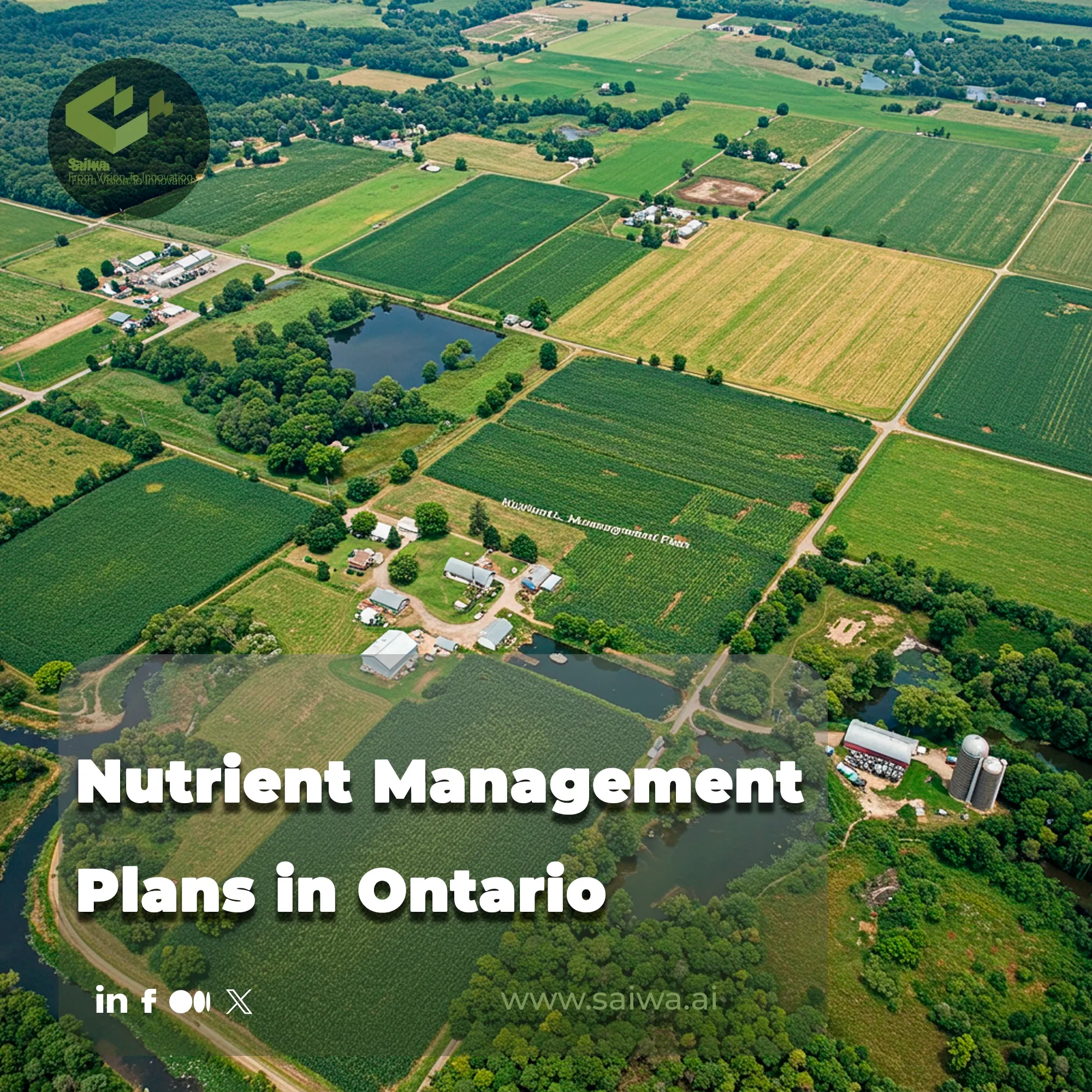Nutrient Management Plans in Ontario: How Precision Agriculture Is Optimizing Farm Sustainability

Ontario’s agri-food industry contributed almost CA$51 billion to the provincial economy in 2023 and supported over 871,000 jobs. but sustaining that level of production depends heavily on how nutrients are managed across Ontario’s 11.8 million acres of farmland. Excess nutrient application from fertilizers and manure causes water contamination through phosphorus and nitrogen runoff, contributing to harmful algal blooms in Lake Erie and degrading drinking water sources across the province.
Conventional fertiliser management is based on the application of uniform rates across entire areas, disregarding the specific characteristics of the soil and the particular requirements of the crops in that particular area.
Nutrient Management Plans address these challenges by providing formal, data-driven frameworks matching nutrient inputs precisely to crop requirements while minimizing environmental impacts.
This guide is a comprehensive exploration of Nutrient Management Plans in Ontario. It examines legal requirements, essential components, creation processes and tangible benefits for farm operations.
What Are Nutrient Management Plans?
Nutrient Management Plans are formal, site-specific documents outlining optimal application of nutrients to cropland, matching inputs from manure, commercial fertilisers, and organic materials with specific crop needs to maximise yield while minimising environmental risks like water contamination.
These plans integrate soil testing data, crop nutrient requirements, available nutrient sources and field-specific characteristics, including sensitive features like wells, tile drains and waterways. This information is used to create comprehensive application strategies.
Why You Need A Nutrient Management Plan
Nutrient precision ensures that fertilisers and organic amendments are applied at the optimum rate, time and location to match each field's true crop requirements. By adjusting nutrient inputs to align with actual soil conditions and plant demand, you can achieve the following benefits:
- improve crop performance and consistency
- avoid unnecessary fertilizer costs by eliminating over-application
- cut nutrient losses that contribute to ammonia emissions and air-quality problems
- protect rivers, lakes, and wetlands from nitrate leaching and phosphorus-driven runoff
- reduce greenhouse gas emissions tied to inefficient nutrient use
How Nutrient Management Planning Works
Creating and implementing effective Nutrient Management Plans involves systematic processes integrating field data, agronomic principles, and regulatory requirements:
- Comprehensive Soil Sampling and Analysis: Plans begin with detailed soil testing across individual fields measuring existing fertility levels including nitrogen, phosphorus, potassium, pH, and organic matter content.
- Nutrient Source Inventory: Planners document all nutrient sources available to the operation including commercial fertilizers with known nutrient compositions, livestock manure with tested or estimated nutrient concentrationsc. Accurate source characterization ensures application rates account for all nutrient contributions.
- Crop Rotation and Yield Goal Planning: Plans incorporate crop sequences and realistic yield targets based on historical performance, soil capabilities, and management practices.
- 4R Nutrient Stewardship Application: Plans apply the 4R principles systematically by selecting appropriate nutrient forms matching crop uptake patterns, calculating rates based on soil tests and yield goals minus credits from manure and residues.
- Regulatory Compliance Verification: Completed plans demonstrate adherence to Ontario's Nutrient Management Act requirements including mandated storage capacities preventing winter application on frozen ground, setback distances protecting water sources, and application restrictions during vulnerable periods when nutrient transport risks peak.

Evidence That Nutrient Management Produce Results
- The Canada-Ontario Lake Erie Action Plan reports that nearly 2,500 farms covering over 384,000 hectares are following 4R Best Management Practices (BMPs) under the Ontario 4R Certification program.
- In Ontario, using 4R BMPs in corn production (particularly subsurface banding of phosphorus fertilizer instead of broadcasting) has been shown to reduce dissolved phosphorus runoff losses by up to 60%.
- Conservation Authorities and OMAFRA are collaborating to monitor water quality and phosphorus runoff. One such project is "Examining the Efficacy of Nutrient Management Practices for Agricultural Landscapes." Among other findings, BMPs have been shown to reduce phosphorus losses during hydrological events and heavy rainfall, which often result in the largest amounts of nutrient runoff.
Who Requires Nutrient Management Plans in Ontario
Ontario's regulatory framework establishes specific thresholds and scenarios triggering formal planning requirements:
- Livestock Operations Exceeding 300 Nutrient Units: Farms with livestock density surpassing 300 NU calculated based on animal numbers and types must develop and implement complete Nutrient Management Plans. This threshold targets operations generating substantial manure volumes requiring systematic management preventing environmental impacts through excessive land application.
- New or Expanding Agricultural Infrastructure: Any operation applying for municipal building permits to construct or expand barns, manure storage facilities, or related structures on farms exceeding 5 NU requires approved Nutrient Management Strategies before permit issuance. This requirement ensures new infrastructure integrates sustainably with existing farm systems.
- Non-Agricultural Source Material Users: Farms applying materials like leaf and yard waste, food processing byproducts, pulp and paper biosolids, or other non-farm organic materials to cropland must follow specific planning and application regulations. These requirements ensure safe, environmentally responsible use of beneficial materials.
- Cost-Share and Grant Program Participants: Producers seeking provincial or federal funding through programs offered by organizations like Ontario Soil and Crop Improvement Association require current Environmental Farm Plans and crop nutrient plans. These documents demonstrate operations implement sustainable practices warranting public investment.
- Voluntary Adopters Seeking Operational Excellence: Many farmers below regulatory thresholds voluntarily implement nutrient planning recognizing benefits including optimized input costs through precision application, improved crop yields through better nutrient management, enhanced soil health through balanced applications, and demonstrated environmental stewardship supporting farm succession and social license.
Benefits and Challenges of Nutrient Management Planning
Benefits and challenges often arise together whenever new systems are introduced. Understanding both sides is essential for balanced decision-making and effective long-term planning.
Key Advantages
Ensures Regulatory Compliance: Approved plans demonstrate formal adherence to the Nutrient Management Act, preventing potential fines, enabling building permit acquisition, and ensuring operations receive official recognition for following sustainable practices.
- Optimizes Crop Yields and Soil Health: Precision matching of nutrient availability to crop needs based on soil tests and realistic yield goals prevents deficiencies limiting production or toxicities reducing quality. Balanced applications build soil organic matter over time, improving long-term productivity.
- Reduces Input Costs: Accurate planning eliminates waste from over-application by accounting for nutrients in manure, soil reserves, and crop residues. Farmers implementing comprehensive plans typically reduce commercial fertilizer expenses 15-30% while maintaining or improving yields.
- Protects Water Resources: Following setback requirements, application timing restrictions, and placement best practices minimizes nutrient transport to surface water and groundwater.
Enables Infrastructure Development: Approved Nutrient Management Strategies satisfy mandatory requirements for municipal building permits, allowing farm expansion and modernization that would otherwise be blocked by regulatory barriers.
Challenges
- Initial Development Investment: Professional plan creation requires fees for certified planners, soil testing costs, manure analysis expenses, and time invested in data collection and decision-making. Small operations may find these upfront costs burdensome despite long-term benefits.
- Ongoing Record-Keeping Requirements: Plans require detailed documentation of application dates, rates, methods, weather conditions, and field observations. Maintaining compliant records demands discipline and time that busy farm operations may struggle to prioritize consistently.
- Technical Complexity: Understanding nutrient cycling, interpreting soil test results, calculating application rates accounting for multiple sources, and following regulatory requirements challenges farmers without agronomic training or access to professional support.

How to Create Compliant Nutrient Management Plans
Farmers and agricultural operations benefit from systematic approaches ensuring plans meet regulatory requirements while delivering operational value:
- Engage Certified Planners: Work with OMAFRA-certified Nutrient Management Plan developers possessing required qualifications and knowledge of current regulations. These professionals guide plan creation, ensure compliance, and provide expertise in agronomic best practices.
- Conduct Comprehensive Soil Testing: Sample fields systematically following protocols for representative results, test through accredited laboratories measuring all required parameters, and repeat testing on appropriate schedules (typically every 3-5 years) maintaining current fertility status information.
- Characterize All Nutrient Sources: Test manure samples from storage facilities determining actual nutrient concentrations rather than relying on book values, obtain guaranteed analyses for commercial fertilizers, and account for nutrients from all sources including crop residues and nitrogen-fixing legumes.
- Map Fields and Sensitive Features: Document field boundaries, identify and map all sensitive features including water wells with required setback distances, tile drains, surface water bodies, and steep slopes.
Implement 4R Nutrient Stewardship: Apply the framework systematically by selecting appropriate nutrient forms, calculating rates based on soil tests and realistic yield goals, timing applications to match crop demand, and placing nutrients where roots access them efficiently. - Maintain Detailed Records: Document all applications including dates, products used, rates applied, methods employed, weather conditions, and field observations. These records demonstrate compliance, support plan updates, and provide data improving future management decisions.
How Can I Get My Nutrient Plan?
This process generally involves soil sampling, nutrient testing and field-specific calculations, which are carried out by an agronomist or adviser with training in nutrient planning.
Following the analysis, your adviser will provide a comprehensive overview of the recommendations, including guidance on implementing the plan throughout the season and updating it as field conditions, crop types, or nutrient sources evolve.
A well-documented plan ensures that all the information you need is always readily available, whether you are preparing for audits, adjusting fertilizer strategies or tracking compliance with environmental standards.
In Saiwa and specifically in Sairone health monitoring solution one can access nutrient management planning services as follows:
- High-resolution satellite and drone-based field monitoring to identify under stress and nutrient-deficient zones and spatial variability across fields.
- AI-powered soil pattern and vegetation analysis to support precise nutrient recommendations.
- Time-series monitoring of crop performance to evaluate whether nutrient applications match crop demand throughout the season.
- Automated detection of high-risk runoff zones, tile-drain pathways, and environmentally sensitive areas requiring adjusted application rates.
- Integration of multi-year field data to track soil fertility changes and support long-term nutrient optimization.
- Early detection of crop stress (nitrogen deficiency, moisture imbalance, disease interaction) enabling in-season adjustments.
- Field-level reporting dashboards and mapping through Atlas module that simplify compliance documentation for auditors and certified planners.
- Seamless data export for agronomists preparing nutrient management plans and updating them as field conditions evolve.

Conclusion
Nutrient Management Plans have changed a lot. They used to be a way for the government to make rules about farming. Now they are a way for farmers in Ontario to be more productive and protect the environment at the same time. These documents combine soil testing, crop needs, and details about the location to help decide how much fertilizer to use.
In my opinion, the future of nutrient management in Ontario will depend heavily on the integration of digital intelligence into everyday farm decision-making. At Saiwa, we see how tools like services we provide in our health monitoring solution can transform traditional planning by offering real-time field insights, spatial nutrient diagnostics, and evidence-based recommendations that strengthen both productivity and environmental stewardship.
When farmers combine regulatory compliance with data-driven precision, they unlock a more resilient, sustainable, and economically efficient farming system—one that meets today’s demands while safeguarding soil and water resources for the next generation.
Note: Some visuals on this blog post were generated using AI tools.
